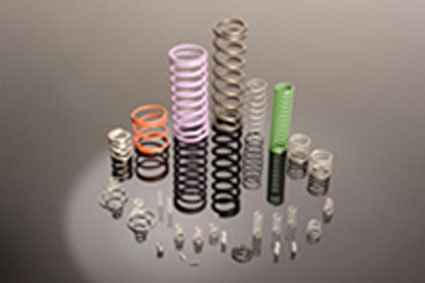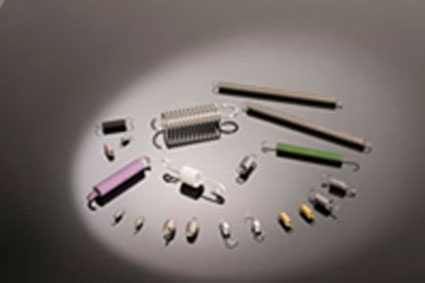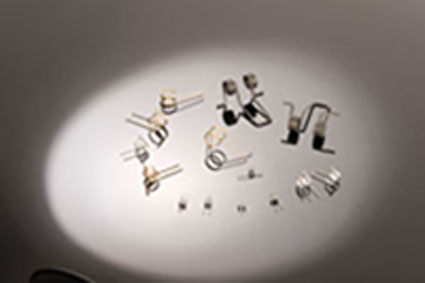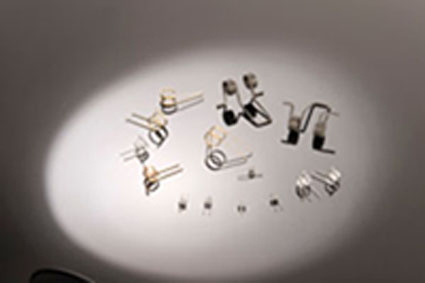
Compression Springs also referred to as helical springs, or coil compression springs, come in a variety of different body shapes such as conical or concave springs (barrel springs), convex springs (hourglass), or tapered springs (one end has a larger diameter than the opposite end).
The related characteristics of each coil compression spring exhibit open coils in a helical configuration and exert resistance to compressive forces when applied axially. Most coil compression springs are made from round wire, but can be made from square, rectangular or a host of other uncommonly shaped wire specific to various applications and needs.
Tips for Designing a Compression Spring
Although compression springs appear to be simplistic in design, big or small compression springs are very complex. There are a number of design considerations that need to be given prior to specifying a compression spring to fit in any given application. First, a designer needs to look at the space allotted for the spring which will help to determine the dimensional limits and if those limits will allow the part to meet the load requirements for the application. As these limits are specified, it is then necessary to determine the stress levels at which the spring will function. If the design shows that the spring is overstressed, the spring will not function properly and possibly lead to costly design changes.Rowley Spring and Stamping offers design assistance. We are happy to have our staff lend their expertise to help determine the right spring for an application.
Compression springs can be found in many different applications from simple ball point pens to precision surgical equipment and the world's most sophisticated aircraft.
Contact Rowley Spring today to discuss your design considerations from small compression springs to any compression springs that you are considering for your application.

An extension spring works as the exact opposite of a compression spring that exerts resistance to compressive forces when applied axially. An extension spring will actually absorb and store energy and provide resistance to a pull force. Each extension spring, also known as tension springs, is made similar in geometry. They are typically closed coil wound but the ends are fabricated to accommodate specific design requirements and are usually attached to the source of the opposing force.
Most extension springs are wound with what's called initial tension. This is the internal force that holds the coils tightly together. The measure of the initial tension is the load necessary to overcome the internal force and start the coil separation. The end configuration is without limits. The most popular are the machine hook, crossover hook, side hook, or extended hook, but the final design will depend on the needs of the application.
Tips for Designing an Extension Spring:
Extension springs can be designed to meet specific needs to fit the application and to function in a manner suited for its purpose. When designing the spring, it is suggested that the engineer spec out no more than three fourths of its maximum working stress level. We would recommend that you consult with our spring engineers prior to finalizing your spring designs. In doing so, this will help to avoid failure of the assembly and potential costly repairs and unnecessary downtime. Extension springs are used in many different applications and you can typically find them in all major household appliances, medical devices, military/aerospace applications and many more. Contact Rowley Spring today, for all your extension springs or small extension springs requirements.
Torsion springs are helical springs that make use of its torque or rotational force. Torsion springs will typically have ends or legs that when rotated or twisted around its center, stores energy and offer resistance to an externally applied source. The limits of the torsion values are dependent on the bending stresses of the wire and not necessarily the torsional stresses. Torsion springs are usually close wound and will reduce in coil diameter, increase in body length during the action of rotation or also known as the angular deflection.
Tips for Designing a Torsion Spring:
Some of the key considerations in the design phase are the effects of friction and the arm deflection on the torque. To reduce the effects of friction, the design may include a pitch (the amount of space between each coil), and the inside diameter should be sufficient to provide clearance when maximum deflection is applied. The leg end configurations are limitless here, but careful consideration should be used if cost is a factor. The design ends can be as simple straight legs, hooks, or angular bends and may assist or aid with part retention. More complex geometries are possible such as full or multiple loops or a number of offsets in order to fit the assembly designs. Any design considerations can be discussed with one of our design consultants.Torsion springs or torsional springs are used in many different applications and you can typically find them in all major household appliances, medical devices, military/aerospace applications plus many more.

A double torsion spring is just as the name suggests. It is simply a spring that is designed to incorporate two torsion springs within one unit. It consists of one set of coils, wound in a right hand fashion and another set of coils, wound in a left hand fashion and are bridged through the center. The total force of a double torsion spring is the sum of the two springs added together.
Torsion springs or torsional springs and double torsion springs are used in many different applications and you can typically find them in all major household appliances, medical devices, military/aerospace applications plus many more.
Tips for Designing a Torsion Spring:
Some of the key considerations in the design phase are the effects of friction and the arm deflection on the torque. To reduce the effects of friction, the design may include a pitch (the amount of space between each coil), and the inside diameter should be sufficient to provide clearance when maximum deflection is applied. The leg end configurations are limitless here, but careful consideration should be used if cost is a factor. The design ends can be as simple straight legs, hooks, or angular bends and may assist or aid with part retention. More complex geometries are possible such as full or multiple loops or a number of offsets in order to fit the assembly designs. Any design considerations can be discussed with one of our design consultants.Torsion springs or torsional springs are used in many different applications and you can typically find them in all major household appliances, medical devices, military/aerospace applications plus many more.






